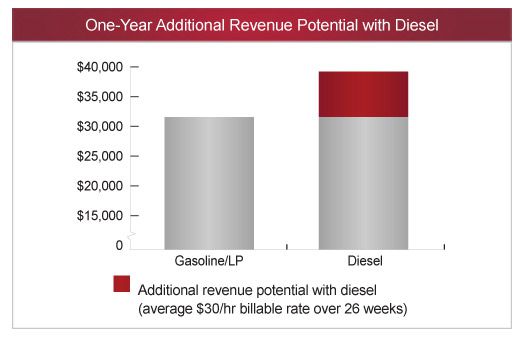True Cost of Ownership
When considering a new equipment purchase, it is important to take into consideration long-term revenues and costs versus short-term "bargains" that result in higher operating costs and lower productivity. With a 3-cylinder, liquid-cooled diesel-powered model, there are five areas of savings to be realized over the life of the mower:
A 25-hp diesel mower engine burns 1.0 gallon per hour (GPH). By comparison, a similar-sized gasoline engine burns 1.65 GPH while an LPG engine burns at the rate of 1.80 GPH. Based on an average mowing season of 1,000 hours (roughly 26 weeks), the diesel-powered mower will burn 900 gallons less than its gasoline counterpart, and 1,050 gallons less than the propane-powered mower.
Although diesel typically costs more per gallon than gasoline and propane, you still save considerable money using diesel based on fuel economy alone. Based strictly on fuel economy, it requires 900 more gallons of gasoline, and 1,050 more gallons of LPG, over 1,000 hours than using diesel. See for yourself with current national fuel price averages how much diesel saves compared to gasoline and LPG over the course of an average 1,000-hour mowing season.
The fuel savings in one year alone can justify the difference in the acquisition cost of the diesel mower compared to gasoline or LPG mowers. Using the diesel mower over two or three seasons just adds more savings to the bottom line.
And the savings don't stop with fuel economy. Using a diesel engine provides more torque to maintain blade tip speed in heavy mowing conditions by giving you the power to finish tough jobs faster.
Combining purchase price and fuel usage, MaxTorque™ diesel models can result in even more savings over the first three years and lead to long-term savings resulting from better fuel economy and lower fuel costs:
It's not uncommon for a liquid-cooled, 3-cylinder MaxTorque™ diesel engine to provide twice the service life of an air-cooled, V-Twin engine. If the air-cooled model has to be replaced twice as often, factor in the cost of purchasing two air-cooled machines for each Grasshopper diesel model, and the diesel savings are apparent.
Diesel models have no spark plugs or plug wires to replace, and because they use less fuel there is less time spent at the pump. Calculate the savings from the operator spending only half as much time filling the fuel tank – up to 70 fewer trips to the gas station each year!
Beyond the cost of ownership, a Grasshopper MaxTorque™ diesel is a solid long-term investment that lays a foundation for future equipment purchases. A significant advantage of MaxTorque™ diesel models lies in trade-in value. Commercial operators traditionally cycle out air-cooled models at two- to three-year intervals, while the equipment still retains nominal value for less demanding applications. Modified (LP) air-cooled riders, like stand-on mowers, have virtually no after-market value. MaxTorque™ diesel models, on the other hand, double or triple the useful life cycle, allowing the owner to cash in big at trade-in time, or to continue reaping return on investment by keeping the unit in use for more years. Several Grasshopper diesel-powered mowers are still operating with over 10,000 hours on the original engine.
Once a transition is made to Grasshopper MaxTorque™ diesel models, it makes little financial sense to use anything else. Financial benefits are realized immediately with reduced fuel costs and a longer service life, and when combined with superior resale value keep replacement costs minimal versus other alternatives.
Clearly, the cost of ownership and operation versus the cost of acquisition is to the advantage of a diesel-powered Grasshopper mower when the scope of the contracts and job sites require hard-working, efficient zero-turn mowers and grounds maintenance systems.



